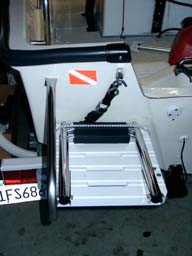sytech
Contributor
After a dive today here in Bonaire, several of us were talking and trying to figure out the following:
Why do so many dive boats have ladders made of metal tubes with tubular steps which are difficult to negotiate because of the lack of traction as well as tubular handrails which have no places upon which you can get a secure grip and all of this while wearing heavy equipment on a boat that is rocking with the waves?
I'm "assuming" that there must be a "reason" for this but can't think of any and can't think of why there can't be rubber (or other material) and/ or textured metal (which I see only rarely) to allow a diver a more secure and safer entry from the water?
Would appreciate hearing from others on this.
Sy
Why do so many dive boats have ladders made of metal tubes with tubular steps which are difficult to negotiate because of the lack of traction as well as tubular handrails which have no places upon which you can get a secure grip and all of this while wearing heavy equipment on a boat that is rocking with the waves?
I'm "assuming" that there must be a "reason" for this but can't think of any and can't think of why there can't be rubber (or other material) and/ or textured metal (which I see only rarely) to allow a diver a more secure and safer entry from the water?
Would appreciate hearing from others on this.
Sy





